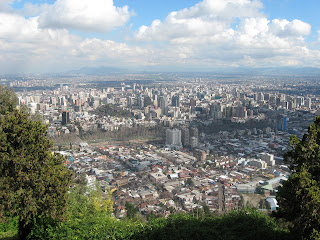
Last weekend we had a beautiful day for our tour of Valparaíso, which was postponed 3 weeks ago because of weather. There are only 19 students on our program, but we got a full-size tour bus—I was surprised because we were going up in the cerros, where the roads are world-famous for being very steep and narrow. But, all Chilean bus drivers are dauntless, and we made it around some crazy curves and past some rushed micro conductors.
Our first stop was La Sebastiana, one of Pablo Neruda’s houses. It has an absolutely beautiful view of the hills and the bay. Four stories tall, with about one room on each floor, the house is full of stuff Neruda collected throughout his life; for example, a porcelain cow, with removable lid, in which he used to mix drinks. There are lots of big windows and some portholes in the stairways, because the house was designed with a nautical theme in mind; Neruda said he loved to go on voyages, but mostly imaginary ones. Standing by his writing desk on the top floor and watching the kites and birds over the houses with the ocean beyond, it was lovely.
Next we took a walking tour of Cerro Concepción, the part of the city that’s been named “Patrimonio Cultural de la Humanidad,” a World Heritage Site. Unlike the other cerro I’d visited, Cerro Concepción had bigger, color-coordinated houses, lots of murals, and classy restaurants and hotels—all on the sides of the steep hill. (Today I went back with friends and splurged on lunch at the place with best view…the Chilean word for how nice that was is riiiico.) It’s a charming and unique place with a lot of history—like the Anglican church that doesn’t have a steeple because it couldn’t stand out on top of a hill in a country where everyone had to be Catholic (no longer a law). And I finally got to take an ascensor (funicular railway) just like Ché does in The Motorcylce Diaries!

Now that I’ve been here for more than a month (!!), I can appreciate the differences between Viña del Mar and Valparaíso. They have pretty distinct characters. Viña is a resort town, with the beaches and some upscale hotels and restaurants near them, and with residencial sectors in the cerros and to the east, where my journalism school is. Upper-class people (class is well-defined here) generally live in Viña rather than Valpo, and it’s safer to walk around at night, which I assume is why the program placed us here. Viña is a beautiful city and I like living here, being able to walk to the beach and, I admit, to the mall, is comforting; but while it’s definitely Chilean in many ways, Viña is much more like any other city than Valpo is.
Valparaíso is totally different from and has a different feel than any other place I’ve been before. I think it’s because it’s a port city, and a very isolated one. On Cerro Concepción I really felt like I was on the edge of the world. There’s a sense of going back in history to when Valparaíso was the first port after Cape Horn, and the sailors could pick out their houses because their families painted them so brightly. The other thing about Valpo is how chaotic it is, at least in the cerros (there’s also a grid, the ‘plan’ section, which is much easier to navegate but still chaotic because of the traffic and markets). Unlike almost every other city in South America, it was never officially founded or planned out; it just expanded randomly. So a map of the cerros is a bunch of squiggly lines—and as I enjoy mentioning, the roads are super steep. Like our tour guide said, Valparaíso is a city in 3-D.
I think my Spanish is getting better gradually, and I can recognize and appreciate lots of Chilean words and the cadence of their speech, which is different from the way people talked in Spain. Watching Chilean telenovelas is fun and a good way to get used to Chilenismos. My 11-year-old Chilean sister filled up several sheets of paper explaining to me the backstories of 2 different telenovelas, but it didn’t all sink in…






